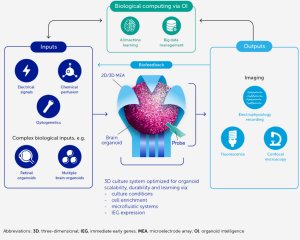What are ‘bio-computers’ and what can they tell us about the human brain?
Why in News?
Recently, Scientists have outlined a plan for a potentially revolutionary new area of research called “organoid intelligence”, which aims to create “biocomputers”, where 3D brain cultures grown in the lab are coupled to real-world sensors and input/output devices.
Technology is expected to harness the processing power of the brain and understand the biological basis of human cognition, learning, and various neurological disorders.
What is this Technology?
- These “mini-brains”(with a size of up to 4 mm) are built using human stem cells and capture many structural and functional features of a developing human br It is used to study human brain development and test drugs to see how they respond.
- However, Brain organoids developed in the lab are not advanced enough as they lack the required sensory inputs and blood circulation that are necessary for the development of a complex organ like the human brain.

- Moreover, Scientists transplanted human brain organoid cultures into rat brains and observed that they formed connections with the rat brain and showed functional activity.
- This system could provide a way to study brain diseasesin a human context.
- However, the organoids are still in the rat-brain microenvironment, which may not be representative of the human brain.
What is the New ‘Bio-computer’?
- Researchers plan to combine brain organoids with modern computing methods using machine learning to create “bio-computers”.
- They will grow organoids inside structures with multiple electrodes that can record the firing patterns of neurons and mimic sensory stimuli.
- Machine-learning techniques will then be used to analyse the effect of neuron response patterns on human behaviour or biology.
- Scientists have already grown human neurons on a microelectrode array and trained them to generate electrical activity similar to what electrons would generate while playing table tennis.
What are the Opportunities for ‘Bio-Computers’?
- Brain organoids developed using stem cells from individuals with diseases like Parkinson’s disease and microcephaly can aid drug development for these conditions.
- These organoids can provide insights into the biological basis of human cognition, learning, and memory by comparing the data on brain structure, connections, and signalling between healthy and patient-derived organoids.
- While human brains are slower than computers at simple arithmetic, they outshine machines at processing complex information.
Way Forward
- Currently, brain organoids have a diameter of less than 1 mm, roughly three millionth the size of an actual human brain. So, scaling up the brain organoid is key to improving its computing capacity.
- Neural recordings from each neuron and connection will be needed to store and analyse using ‘Big Data’ infrastructure.
- Researchers will also have to develop microfluidic systems to transport oxygen and nutrients and remove waste products.
- There is also a need to identify, discuss, and analyse ethical issues as they arise in the course of this work.
